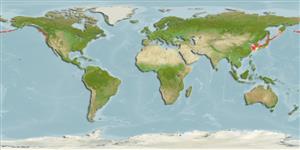Environment: milieu / climate zone / depth range / distribution range
ນິເວດວິທະຍາ
ສັດທະເລ ອາໄສຢູ່ໃກ້ໜ້າດິນໃຕ້ພື້ນທ້ອງນ້ຳ; ປາທີ່ມີການເຄື່ອນຍ້າຍໃນສະເພາະມາະຫາສະມຸດ (Ref. 51243); ລະດັບຄວາມເລິກ 0 - 172 m (Ref. 114018). Temperate; 54°N - 30°N, 118°E - 118°W
Northwest Pacific: inland Sea of Japan to Kyushu, Japan. Northeast Pacific: From southern California to the western Aleutian Islands (Ref. 114018), Alaska (Ref. 11366).
ຂະໜາດ / ນ້ຳໜັກ / Age
Maturity: Lm ? range ? - ? cm
Max length : 15.0 cm SL ຕົວຜູ້/ບໍ່ມີເພດ; (Ref. 559); common length : 10.0 cm SL ຕົວຜູ້/ບໍ່ມີເພດ; (Ref. 559); ນ້ຳໜັກສູງສຸດທີ່ເຄຍຈັດພີມມາ: 10.60 g (Ref. 112063); ອາຍຸສູງສຸດທີ່ເຄຍລາຍງານມາ: 3.00 ປີ (Ref. 125612)
ຄີ (ໜາມ)ແຂງຢູ່ຫຼັງປາ (ທັງໝົດ) : 0; ຄີຫຼັງຂອງປາ (ຄີອ່ອນ) (ທັງໝົດ) : 55 - 59; ຄີ(ໜາມ) ແຂງຢູ່ຄີກົ້ນປາ
ກຸ່ມປາກະດູກແຂງ
ຄວາມຖີ່ຂອງກຸ່ມຖ່າຍທອດພັນ
ປາທີ່ມີການເຄື່ອນຍ້າຍຈາກທະເລໄປຫານ້ຳຈືດ ແລະນ້ຳຈືດຫາທະເລ
ປາທີ່ມີການເຄື່ອນຍ້າຍຈາກທະເລແລະໄປໄຂ່ຢູ່ນ້ຳຈືດ
ຄີກົ້ນຂອງປາ
ສັດທີ່ມີກະດູກສັນຫັຼງ
ການຖ່າຍທອດທາງກຳມະພັນຈາກພໍ່ແມ່ຫາລູກ: 0; ຄີກົ້ນຂອງປາ: 28 - 32; ສັດທີ່ມີກະດູກສັນຫຼັງ: 62 - 67. Characterized by having a horizontal skin fold along its ventral contour, and the absence of pelvic fin and teeth. Lateral plicae 160 to 180. Lower jaw pointed. Lateral line system on head not continuous with that on the body.
Found in sand bottoms and may enter semi-enclosed sea areas (Ref. 11230). Forms large schools. Important food fish in Japan (marketed fresh or dried) and marketed fresh but mainly used for meal and oil manufacture in Europe (Ref. 10384). Common size taken from picture in Ref. 559. Maximum size estimated as 1.5 * common size. Two genetically different lineages were found in Japan Sea/East Sea, perhaps representing two different species (J.K. Kim, oral.comm, FishBoL2012, June 2012).
Life cycle and mating behavior
Maturities | ການສືບພັນ | Spawnings | Egg(s) | Fecundities | ຕົວອ່ອນ
Masuda, H., K. Amaoka, C. Araga, T. Uyeno and T. Yoshino, 1984. The fishes of the Japanese Archipelago. Vol. 1. Tokai University Press, Tokyo, Japan. 437 p. (text). (Ref. 559)
IUCN Red List Status (Ref. 130435)
Threat to humans
Harmless
Human uses
ການປະມົງ: ທີ່ມີການຄ້າສູງ
ເຄື່ອງມື
Special reports
Download XML
ແຫຼ່ງອີນເຕີເນັດ
Estimates based on models
Preferred temperature (Ref.
123201): 11.9 - 23, mean 19.1 °C (based on 74 cells).
Phylogenetic diversity index (Ref.
82804): PD
50 = 0.5156 [Uniqueness, from 0.5 = low to 2.0 = high].
Bayesian length-weight: a=0.01000 (0.00524 - 0.01907), b=3.23 (3.06 - 3.40), in cm total length, based on LWR estimates for this species & Genus-body shape (Ref.
93245).
ຊັ້ນເຂດຮ້ອນ (Ref.
69278): 3.1 ±0.1 se; based on size and trophs of closest relatives
Generation time: 1.1 ( na - na) years. Estimated as median ln(3)/K based on 1
growth studies.
ຄວາມຢືດຢຸ່ນ (Ref.
120179): ສູງ, ປະຊາກອນຕຳ່ສຸດທີ່ໃຊ້ເວລາສອງໜ້ອຍກວ່າ 15 ເດືອນ (K=0.6).
Prior r = 0.79, 95% CL = 0.52 - 1.18, Based on 4 data-limited stock assessments.
Fishing Vulnerability (Ref.
59153): Low vulnerability (14 of 100).
Climate Vulnerability (Ref.
125649): Low vulnerability (17 of 100).
Nutrients (Ref.
124155): Calcium = 86.7 [47.1, 189.0] mg/100g; Iron = 0.509 [0.278, 0.951] mg/100g; Protein = 18.8 [17.3, 20.2] %; Omega3 = 0.467 [0.238, 0.873] g/100g; Selenium = 12.6 [5.7, 28.3] μg/100g; VitaminA = 31.4 [7.8, 121.8] μg/100g; Zinc = 0.773 [0.521, 1.136] mg/100g (wet weight);
